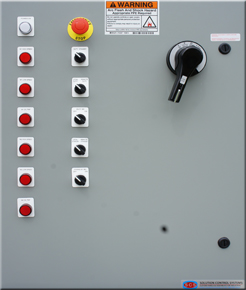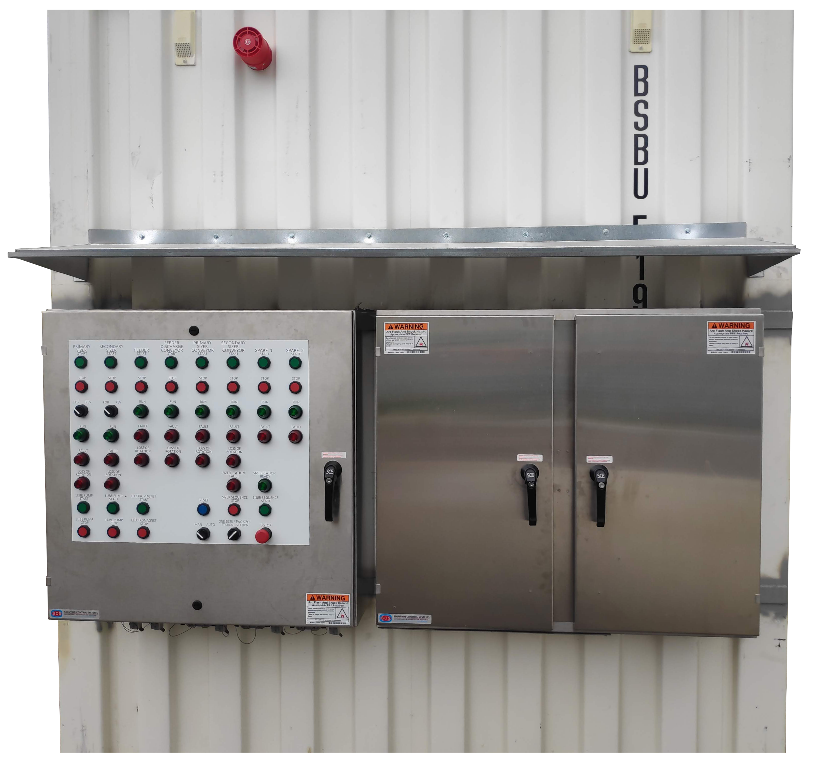The machinery framework by control panel manufacturer states about panels consisting of power circuits which provide signals directing towards the performance of the equipment. This panel is mounted over a back panel as per the requirement of its application. Taking note of the design guide provided by the control panel manufacturer, control panel design initiates with evaluating design requirements with specifications and developing plans.
What is an Industrial Control Panel?
An Industrial Control Panel is an assembly of electrical components used to control machinery and equipment in industrial settings. It typically includes devices like switches, circuit breakers, relays, programmable logic controllers (PLCs), and motor starters, all housed in a protective enclosure. These panels manage and automate processes, ensuring safe, efficient, and reliable operation of systems across manufacturing, power distribution, and other industrial applications. They ensure efficient and safe system functionality.
Essential Components of an Industrial Control Panel
Essential components of an industrial control panel include circuit breakers for protection, contactors and relays for switching, PLCs for automation, terminal blocks for wiring connections, and HMIs for operator interface. Power supplies convert incoming power to required voltages, while fuses and surge protectors ensure safety. Together, these components enable efficient monitoring, control, and protection of industrial machinery and processes.
Industrial-Based Control Panel Design:
The development of control panel design for industrial equipment and machinery is intended to control a machine. It is not easy to select a suitable enclosure and a back panel compatible with the electrical hardware. This means that hardware should be mounted appropriately over a back panel and accurately integrated into the machine. One thing to note is that any wrong configuration can result in faulty machinery and a risk to its operators.
The procedure needs to initiate an evaluation of the requirements, specifications, and regulatory standards. After these reflections are checked, drawings are managed to outline the detailed configuration of circuits, wiring, controls, and every other aspect of the concluding control panel. Good design is meant to indicate the electrical as well as physical requirements.
Step-by-Step Guide to Designing an Industrial Control Panel
Designing an Industrial Control Panel involves several key steps:
-
Define Requirements – Identify the system’s operational needs, inputs, outputs, and environmental conditions.
-
Create Schematic Diagram – Draft electrical schematics showing control logic, wiring, and component connections.
-
Select Components – Choose appropriate devices like breakers, PLCs, and relays based on load and function.
-
Design Panel Layout – Arrange components for accessibility, ventilation, and space efficiency within the enclosure.
-
Ensure Compliance – Follow relevant codes and standards like NEC, UL508A, and CSA for safety and certification.
-
Assemble the Panel – Physically install and mount components inside the enclosure as per the design.
-
Wire Components – Connect all devices according to the wiring diagram, ensuring neat and secure terminations.
-
Test the Panel – Perform electrical and functional testing to verify proper operation and safety.
-
Label and Document – Clearly label components and provide detailed drawings and manuals for future reference.
-
Install and Commission – Mount the panel at the site, connect it to the system, and run final commissioning checks.
Importance of Regulatory Compliance in Control Panel Design
Even with numerous Code cycles, some of the industrial control panels are not amenable with the regulatory standards accepted in the entire industry. The compliance is perilous for certifying minimal safety risks linked with installing and functional industrial equipment. The National Electrical Code(NEC), or NFPA 70, is a standard meant for the safe connection of electrical equipment and wiring. It is implemented by a state or a region to regulate the execution of safe electrical practices.
Many design considerations must be evaluated throughout the design procedure of developing a control panel. This panel is intended to meet functional necessities, application provisions, and regulatory norms. The design decisions made by the authorities represent the chief design concerns in creating an industrial control panel.
Positioning is another concern linked with enclosures. Depending on the placement of the panel, one needs to account for swing supplies of cabinet doors. If a control panel is placed in an area having high ambient temperature, a ventilation fan might be needed to allow the proper functioning of the control panel. Power wiring and heat-producing devices must have NEC clearance before usage; so that sufficient room for ventilation is possible.
Also Read: 10 Signs: You May Need to Replace Your Electric Control Panel
It is known that space considerations are supreme. It is because one of the most common NEC defilements includes smaller control panels allowing the proper space for wiring and wire bending. It is also justified to make space needs for the existing configuration as well as futuristic needs because restrictive space is quite a challenge for retrofits. This mechanism is essential to handle because nothing goes wrong with electrical malfunctioning. After all, the safety of the machine and its operator is highly significant.
Importance of Placement and Positioning of Industrial Control Panels
Proper placement and positioning of industrial control panels are critical for safety, accessibility, and efficient operation. Panels should be installed in well-ventilated, dry, and easily accessible areas to allow for maintenance and emergency shutdowns. Strategic positioning also minimizes wiring complexity and reduces installation costs. Compliance with regulations ensures operator safety and long-term reliability of the control system.
Common Challenges in Control Panel Design and How to Overcome Them
Common challenges in control panel design include space limitations, heat buildup, wiring complexity, and ensuring code compliance. These can be overcome by careful planning, using compact and modular components, implementing proper ventilation or cooling systems, and following industry standards. Early collaboration with end-users and engineers also helps address functional requirements and future expansion needs, ensuring a reliable and maintainable panel.
Conclusion
Industrial control panels are essential for automating and managing complex machinery in modern industrial environments. A well-designed panel ensures safety, reliability, and efficiency while meeting operational needs and compliance standards. From component selection to final installation, each step plays a critical role in performance. Investing in quality design and execution leads to reduced downtime, easier maintenance, and long-term operational success.


